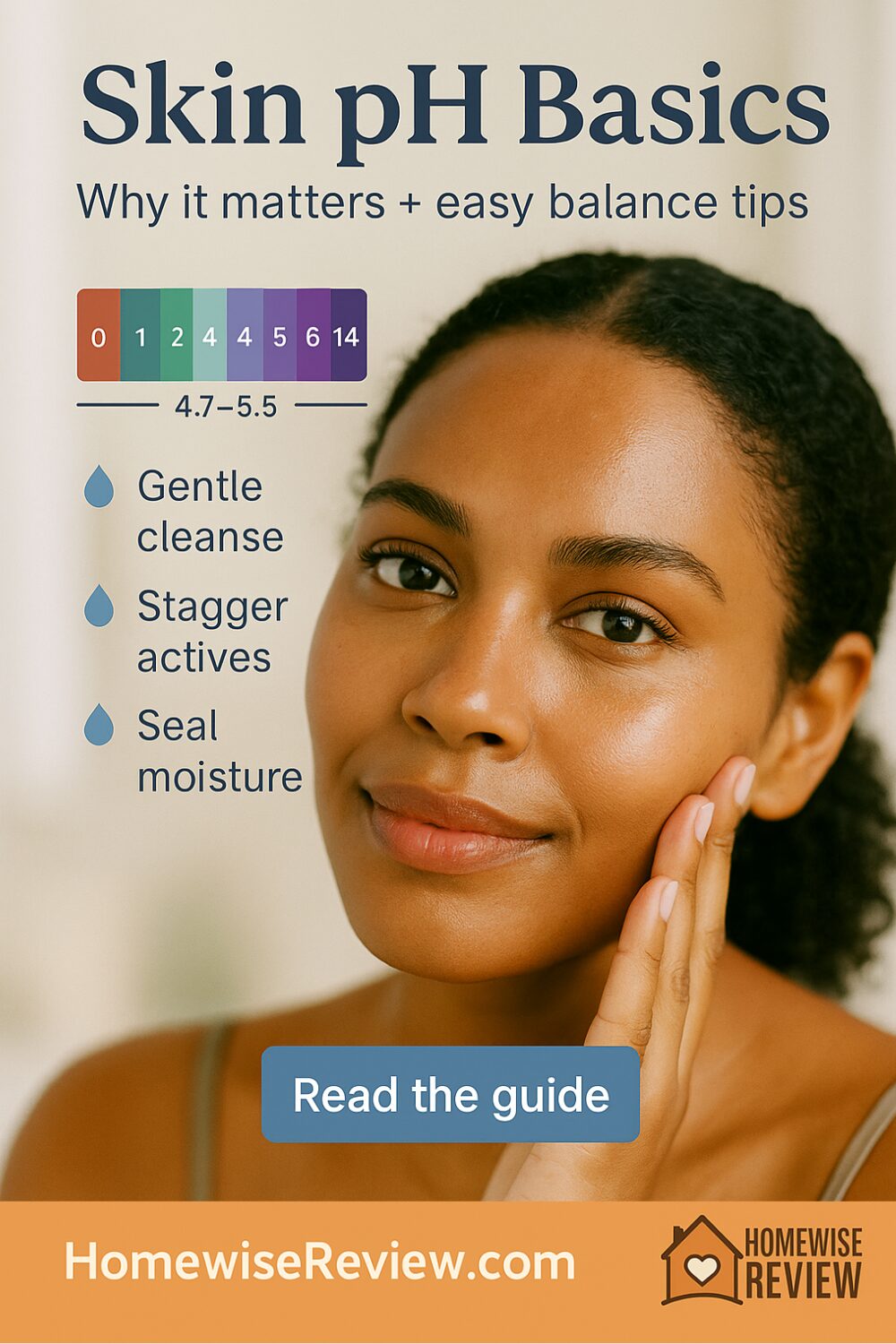
Who this is for: Anyone whose skin swings between oily and tight, stings with new products, or looks dull after washing.
Bottom line: Your skin likes life slightly acidic around pH 4.7 to 5.5. That range keeps the barrier sealed, enzymes working, and the microbiome calm. You keep balance by choosing the right cleanser, rinsing smart, staggering strong actives, and sealing with barrier friendly moisture.
What pH is and what it does for skin
pH is a scale of how acidic or alkaline something is. Your skin wears a thin acidic film called the acid mantle. In that sweet spot, lipids line up, enzymes make fresh barrier, and helpful microbes outcompete opportunists. When rinses or products push skin more alkaline, water escapes faster, oil rebounds, and irritation shows up as redness, flaking, or sudden breakouts.
Plain English: Balanced pH is why a simple routine can look better than a complicated one.
Signs your pH is drifting
- Face feels squeaky or tight right after washing
- Makeup pills or clings to flaky patches
- Rich products seem to sit on top yet you are still dry
- Sudden shine by lunch after a harsh morning cleanse
- Stinging with mild products that used to feel fine
If two or more sound familiar, adjust cleanser first. Most pH problems start at the sink.
The cleanser rule that fixes half of it
Choose syndet cleansers that are labeled gentle, hydrating, or gel cream. These rinse near skin’s natural range, which keeps the barrier calm. Harsh foaming soaps feel clean in hard water, but they push pH up and strip lipids.
Technique tips that matter
- Use lukewarm water, not hot
- Massage for 30 to 60 seconds, then rinse for a full 30 seconds
- Pat dry, do not rub
- If your tap runs hard, try a final splash of low mineral or filtered water and go straight to your next step
Need ideas by skin type
- Dry or mature: cream or lotion cleanser
- Oily or acne prone: gentle gel that cuts oil without squeak
- Sensitive: fragrance light gel cream, short contact time
Exfoliation, acids, and pH the smart way
Acids like lactic, glycolic, mandelic, and salicylic are naturally acidic. They smooth well, but stacking them with low pH toners, vitamin C serums, and retinoids in one pass often does too much.
Simple rules
- Use one strong active at a time at night
- Start acids two nights a week, then step up as tolerated
- Retinoids on alternate nights if you use them
- Barrier moisturizer on top after five to ten minutes
If you are sensitive or dry, consider PHAs like gluconolactone that keep exfoliation gentle.
Moisturizers and serums that support balance
Look for formulas with ceramides, cholesterol, and fatty acids, plus humectants like glycerin and hyaluronic acid. These refill the mortar between skin cells and cut water loss after cleansing.
Helpful add ons
- Niacinamide for tone and oil regulation with low irritation
- Azelaic acid for a more even look without strong acid sting
SPF, makeup, and pH
Sunscreen is non negotiable for a steady barrier. Mineral and chemical filters both sit fine over balanced routines. Let skincare set for a minute, then apply SPF. If base pills, you are likely stacking too many layers or applying before the last step has gripped. Press a damp sponge to fuse texture before makeup.
Two simple routines to copy
Morning, 3 steps
- Gentle cleanse or a water rinse if you are dry
- Lightweight serum that suits your goal, for example niacinamide for T zone control
- Moisturizer, then broad spectrum SPF
Night, 4 steps
- Remove makeup and SPF, oil cleanse if needed
- Gentle cleanser
- Either an acid serum or a retinoid, not both
- Barrier moisturizer, richer on dry cheeks
A two week reset for cranky skin
Days 1 to 4
- Gentle cleanser only
- Barrier moisturizer morning and night
- SPF daily
- No acids or retinoids
Days 5 to 8
- Add niacinamide or azelaic acid at night
- Keep moisturizer consistent
Days 9 to 14
- If calm, add one acid night per week or restart your retinoid on alternate nights
- Stop increasing if tingling lasts more than a few minutes or flaking ramps up
Most owners notice less tightness after washing within a week and steadier oil by week two.
Troubleshooting
- Tight but shiny after washing: cleanser too harsh. Switch to gel cream, shorten contact time, and add a hydrating toner before moisturizer.
- Stinging with everything: pause acids for five days, use ceramide rich moisturizer, and keep water lukewarm.
- New flakes around nose and mouth: apply moisturizer within one minute of patting dry so water does not escape.
- Breakouts spike after a new routine: simplify, then add back one product at a time every four nights so you can spot the trigger.
- Hard water issues: see our rinse tips in How Water Hardness Affects Skin: Cleanser Choice and Rinse Tips to reduce mineral film that pushes pH up.
Final Thoughts
Skin likes simple and slightly acidic. Keep the wash step gentle, stagger powerful actives, and seal with a barrier focused moisturizer. Give each change a full two weeks before judging. Balanced pH shows up as calmer cheeks, fewer midday shine swings, and makeup that goes on without a fight.
See Also
If your cleanser is the weak link, start with Best Face Cleansers for Dry Skin, Best Face Cleansers for Sensitive Skin, or Best Face Cleansers for Oily Skin to match texture and strength to your skin. For smoothing that respects balance, Best Exfoliators for Sensitive Skin compares AHAs, BHAs, and PHAs that behave, and Niacinamide Serums for Pores and Tone helps you pick a steady, low drama helper for the T zone.
Sun and minerals nudge pH too. Pair your routine with Mineral Sunscreens That Do Not Leave a White Cast if deeper tones are your match, and keep rinses friendly with the tricks in How Water Hardness Affects Skin: Cleanser Choice and Rinse Tips. If ingredient labels feel like alphabet soup, bookmark The Ultimate Ingredient Decoder for Everyday Products so you can build without guesswork.
FAQs
Do I need a pH balancing toner
Not usually. If your cleanser is gentle and you moisturize promptly, your skin resets on its own. Use hydrating toners for slip and comfort, not to fix a harsh wash.
Can I use vitamin C and acids together
You can, but beginners should split them. Try vitamin C in the morning and acids at night so you do not double down on low pH in one pass.
Is bar soap bad for the face
Most classic soaps rinse alkaline and can strip the barrier. Choose facial cleansers labeled gentle or hydrating instead.
How quickly does skin recover after a harsh cleanse
The surface pH can take several hours to rebalance. During that window you are more prone to stinging, dryness, and oil rebound, which is why a kind cleanser pays off.
Will balanced pH cure acne
No, but it helps reduce irritation that can worsen breakouts. Pair a gentle routine with targeted actives like salicylic acid or azelaic acid and consistent sunscreen.
Affiliate Disclosure
If you purchase through links on our site, we may earn a small commission at no extra cost to you.




